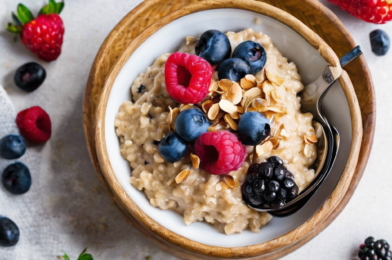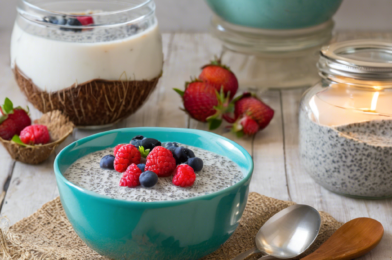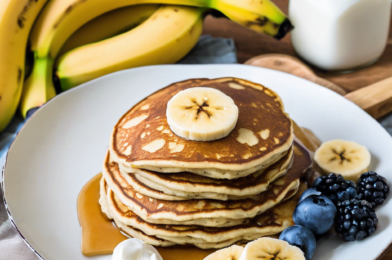I recently tried out a delightful recipe that has quickly become a family favorite: Dairy-Free Oatmeal with Berries. As someone who appreciates both hearty breakfasts and accommodating various dietary needs, I was thrilled with how this dish turned out. My family, notorious for their varied tastes, all gave it a resounding thumbs up. The oatmeal’s creamy texture, despite being dairy-free, coupled with the natural sweetness from the berries, made it an instant hit at our breakfast table. Not only is it delicious, but it’s also a nutritious way to start the day. I found myself looking forward to breakfast every morning just to enjoy this delightful concoction.
Ingredients
Creating this dairy-free oatmeal is a straightforward process, with ingredients easily found in most kitchens or local grocery stores. Here’s what you need to gather:
- 1 cup of rolled oats
- 2 cups of almond milk or any other plant-based milk
- 1 tablespoon of chia seeds
- 1 tablespoon of maple syrup or honey
- 1 teaspoon of vanilla extract
- 1/2 teaspoon of cinnamon
- 1 cup of mixed berries (such as blueberries, raspberries, and strawberries)
- A pinch of salt
- Optional toppings: sliced almonds, coconut flakes, or more fresh berries
Instructions
With your ingredients ready, it’s time to prepare the oatmeal. This process is simple and takes only a few steps. Here’s how you can make this delicious breakfast:
- Start by combining the rolled oats, almond milk, chia seeds, maple syrup, vanilla extract, cinnamon, and salt in a medium saucepan.
- Place the saucepan over medium heat and bring the mixture to a gentle boil, stirring occasionally.
- Once boiling, reduce the heat to low and let the oatmeal simmer for about 10-15 minutes. Stir frequently to prevent sticking and to achieve a creamy consistency.
- Once the oatmeal reaches your desired thickness, remove it from the heat.
- Fold in the mixed berries, allowing their juices to blend with the oatmeal, enhancing both flavor and color.
- Serve the oatmeal warm, garnished with your choice of optional toppings for added texture and flavor.
Nutrition Facts
This recipe makes about four servings, perfect for a family breakfast or for meal prepping. Each serving contains approximately 250 calories, making it a wholesome and satisfying start to your day. The combination of oats and chia seeds provides a healthy dose of fiber, while the berries add antioxidants and essential vitamins.
Preparation Time
The beauty of this dish, aside from its taste and nutritional value, is its quick preparation time. From start to finish, you can have this delicious oatmeal ready in about 20 minutes. This makes it an ideal choice for busy mornings when time is of the essence but a nutritious breakfast is still a priority.
How to Serve
There are several ways you can serve this delightful oatmeal to make it even more enjoyable:
- Family-Style: Serve it in a large bowl, allowing everyone to scoop their desired amount and customize with their favorite toppings.
- Individual Bowls: Portion out the oatmeal into individual bowls, each garnished with a unique combination of toppings for a personalized touch.
- On-the-Go: Prepare the oatmeal in advance and store it in portable containers for a quick and easy breakfast option during busy mornings.
- Brunch Spread: Include this oatmeal as part of a larger brunch spread, paired with other breakfast favorites like scrambled eggs or avocado toast.
- Meal Prep: Make a large batch and store portions in the fridge or freezer for easy reheating throughout the week.
Additional Tips
To enhance your oatmeal experience, consider these additional tips:
- Experiment with Milk Alternatives: While almond milk is a popular choice, feel free to experiment with other plant-based milks such as coconut, oat, or soy milk to find your preferred flavor.
- Use Seasonal Berries: Opt for seasonal berries for the freshest taste. In the summer, fresh strawberries or blueberries are perfect, while in the winter, frozen berries are a convenient and nutritious option.
- Add a Protein Boost: For additional protein, consider topping your oatmeal with a dollop of almond butter or a sprinkle of hemp seeds.
- Make it Overnight: Prepare the oatmeal mixture the night before and let it sit in the fridge overnight. In the morning, simply heat it up for a quick and effortless breakfast.
- Sugar Alternatives: If you’re watching your sugar intake, reduce or omit the maple syrup and rely on the natural sweetness of the berries.
FAQ Section
Here are some frequently asked questions about this dairy-free oatmeal recipe:
Q: Can I use steel-cut oats instead of rolled oats?
A: Yes, but keep in mind that steel-cut oats require a longer cooking time and a bit more liquid. Adjust the cooking time to about 20-30 minutes and add extra almond milk as needed to achieve the desired consistency.
Q: Can I make this oatmeal gluten-free?
A: Absolutely! Just ensure that your oats are labeled gluten-free, as some oats can be cross-contaminated with gluten during processing.
Q: What if I don’t have chia seeds?
A: You can omit the chia seeds if you don’t have them on hand. They add a nice texture and nutritional boost, but the oatmeal will still be delicious without them.
Q: Can I use frozen berries instead of fresh?
A: Yes, frozen berries work just as well and are often more economical. They will thaw as you fold them into the hot oatmeal, releasing their juices and flavor.
Q: How long can I store leftover oatmeal?
A: Leftover oatmeal can be stored in an airtight container in the refrigerator for up to four days. Reheat it on the stovetop or in the microwave, adding a splash of almond milk to restore its creamy texture.




